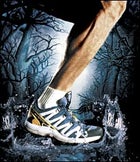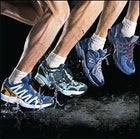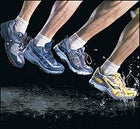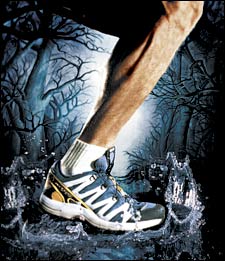IN 1983, WHEN THE FIRST TRAIL RUNNER was unleashed on the world, pavement pounders everywhere quickly derided the newfangled shoes as sneaker SUVs. Indeed, some unfortunate early versions looked more like low-profile hiking boots than running shoes. But soon enough everyone wanted a pair. These days, all the major footwear players stitch up backcountry sprinters designed expressly to tackle roots, rocks, and muck. They’re a long way from being a niche-market afterthought for shoe companies.
 Salmon’s XA Pro Gtx makes a big splash.
Salmon’s XA Pro Gtx makes a big splash.
Any of the eight kicks on the pages that follow will easily propel you through your own private Eco-Challenge or Fugitive-style escape. To help you choose the right pair we’ve enlisted what we’ll call the perceived-weight index. Stay with us.
Perceived weight is a two-part concept: how heavy (or light) the shoe looks when you spy it on the rack and how heavy or light it feels on your foot. So if a tread appears bulky, your brain might trick you into thinking that the overall shoe is heavier than last year’s model—even though the reverse may actually be the case. When it’s time to hit the trail, perceived weight becomes more important than actual weight—a conundrum Angela Flaviani, footwear product manager for The North Face, deals with in every new shoe she oversees. “It’s not raw weight that matters,” she says, “but rather balanced weight dispersion. Without it, an eight-ounce unbalanced shoe can feel heavier than a 12-ounce shoe.” But, in reality, all-terrain foot-wear needs a certain amount of reinforcing muscle. Some companies craftily hide this needed beefiness in the midsole or upper, where it’s less likely to give that lurching, bulldozer-hiker vibe, and—Scout’s honor—feels lighter as well.
Sheesh. All that before you even try the things on. This year’s crop draws from a mixed bag of construction tricks to address the perception problem. Some models keep their deep-lug tread for maximum traction; others are modified marathoners that sacrifice stability for speed. To pick the right shoe, consider your body type, the surfaces you’ll be loping over, the length of your typical run, and whether a substantial-looking shoe will slow you down. When your trail runners are covered in more mud, dust and scratches than your hiking boots, you’ll know you’ve found the perfect match.
 From left: The Salomon’s XA Pro GTX, Nike’s ACG Air Thielsen, New Balance’s 705, and the Adidas Response Trail 8
From left: The Salomon’s XA Pro GTX, Nike’s ACG Air Thielsen, New Balance’s 705, and the Adidas Response Trail 8SALOMON‘s XA Pro GTX ($120) continues a legacy of shoes that thrive in slime, snow, rock, surf, and any other debilitating terrain you can throw their way. In this version, Salomon used Gore-Tex’s more breathable XCR liner, but kept the one-pull Kevlar laces, trail-detritus-blocking gusseted tongue, EVA-cushioned midsole, and full-length protection and support plate between the midsole and outsole from earlier models. Underneath you’ll find the race-proven rubber tread that’s sticky inside for traction and tougher around the edges for durability and a moderate perceived weight. But since Gore’s lining wraps the entire foot, the XA Pro GTX runs stiff—brilliant for a long wet trek, but too hard for a short dry run. (877-272-5666; )
Aggressive muck junkies should consider making the NIKE ACG AIR THIELSEN ($80) their precision platform. This shoe offers a stiff polyurethane insert and reinforced forefoot web under the midsole for protection. A customizable lacing system and a midfoot girdle then work together to lock in your foot. Cover that with an integrated tongue-and-lace overlay that says “ixnay” to any debris sneaking past the ankle, and your feet will feel safer than Fort Knox. But all that security exacts a toll. Despite a light perceived weight and firm EVA in the mid- and rear-foot areas—excellent for stability and control on long runs, through mud and slop, or on traverses—the Thielsen lacks the smooth rebound needed for roadwork. (800-344-6453; )
NEW BALANCE‘s 705 ($78) often plays third fiddle to the company’s more expensive 800- and 900-series all-terrain shoes, an inequity that’s yours to exploit. Thanks to multiple available widths, plus the same plush and stable platform found in the high-priced models, the 705 offers a perfect fit with a moderate perceived weight. The cushioning elastomer in both the forefoot and heel adds up to the most maneuverable and flexible shoe in New Balance’s all-terrain bag—attributes that make this a worthy graded-hardpack trotter with adequate traction should the road unexpectedly turn into a rutted jeep trail. But even with a plastic arch for support and protection, the 705 is no scrambling shoe. (800-253-7463; )
Having once ruled the off-road market, ADIDAS lost its way a few years back when it shifted gears and targeted style-conscious urbanites. Thankfully, the eighth edition of the firm’s classic mud hopper, the RESPONSE TRAIL 8 ($80), will make runners rejoice again. The RT8 could well be called the XLR8, given its smooth ride and light perceived weight. It offers durable water-resistant mesh uppers, an EVA cushioning compound in the heel and elastic EVA cushioning in the forefoot, plus outsole lugs for reliable purchase on loose slopes. The tread is so grippy, it’ll snag on plush pile carpet. Cushy yet firm, the shoe is well suited for one- to three-hour runs on hard-packed dirt or rocky trails. (800-423-4327; )
 From left: Hi-Tec’s Perpetua, The North Face’s Coyote Ridge II, the Asics Gel-Trabuco V, and Saucony’s Grid Xterra
From left: Hi-Tec’s Perpetua, The North Face’s Coyote Ridge II, the Asics Gel-Trabuco V, and Saucony’s Grid Xterra“���ϳԹ��� racing lite” best describes the three- to six-hour slogfests for which the HI-TEC PERPETUA ($65) was designed. Kudos to Hi-Tec for making the shoe affordable yet feature-packed. A light perceived weight belies a moisture-wicking lining, a nylon shank for torsional rigidity and stability, and a removable insole that’s padded in the rear and forefoot for cushioning. Porous uppers dump water quickly after stream crossings, and a nylon-armored toe box fends off shoe-shredding abrasions. For this we say, “Hosanna!” However, the Perpetua is a roomy sneaker with a wide heel cup. For a sure fit, the skinny-heeled and narrow-footed among us will need an aftermarket insert—which pulls these pups into a higher tax bracket. (800-521-1698; )
Spying an opportunity to make a shoe light, supportive, stable, durable, and flexible, THE NORTH FACE produced the COYOTE RIDGE II ($85) and nailed all but one of those goals (people with sensitive arches will want to add an aftermarket insert to beef up support as well as forefoot cushioning). Runners will enjoy the Coyote’s superb performance on gravel, packed dirt, and dry, punishing singletrack. The shoes can handle even more abuse when fitted with a mesh scree gaiter (sold separately). The midsole employs durable mixed rubber/EVA cushioning inserts under the heel and toes and a harder EVA wedge along the inside heel to inhibit pronation—the tendency to run on the inside edges of our feet—to round out a solid winner. (800-447-2333; )
Of all the off-road shoes going, the ASICS GEL-TRABUCO V ($80) earns the most points for versatility. The footbed of this hybrid on-/off-roader— designed for dual-personality runners—flows smoothly from gel-cushioned heel to hard rubber-and-plastic arch to gel-cushioned toe. The arch enhances stability on rugged, rocky, or rooted trails, but the tread’s merely adequate grip (it’s a hybrid, remember?) limits you to more sedate terrain. Despite the weight-shaving materials, the Gel-Trabuco’s perceived weight still gets a boost from an abrasion-resistant carbon-rubber tread and overwrought synthetic-leather styling details. (800-678-9435; )
Those who still insist on running trails in road shoes should try SAUCONY‘s GRID XTERRA ($80). It’s a fast runner with a light perceived weight that feels like a marathoner underfoot. Bantamweights who don’t need extra support, protection, cushioning, or stability will think it’s perfect. Since Saucony placed its impact-cushioning system only in the heels, heavier runners will find it better suited to a park’s gravel trails, where the sprightly feel and responsive toe flex reveal a road-running heritage. For the pronators among you, the Xterra places harder cushioning along the inside of the shoe—complemented by softer cushioning on the outside—to keep feet flat. They’ll carry you up your local hill with ease, but not the ankle-snapping scree found above timberline. (800-365-4933; )


